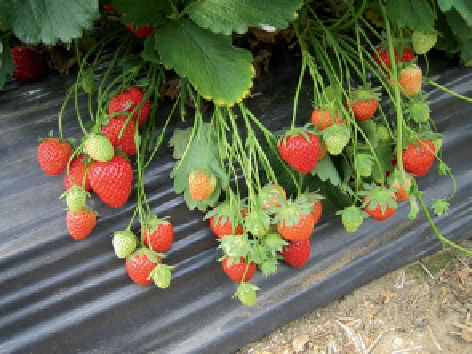Agriculture Reference
In-Depth Information
Fig. 9.1
Strawberry cv.
Fenella, from the East
Malling Strawberry Breeding
Club, UK
ate summers, e.g. the central coast region of California, it is possible to extend
production to 10 months of each year.
Genetic Resources and Breeding Advances
The cultivated strawberry (
Fragaria
x
ananassa
) (Fig.
9.1
) is a hybrid between
two octoploid wild species from the Americas,
F. chiloensis
and
F. virginiana
. The
former is found on the west coast from Alaska to southern Chile, while
F. virginiana
is a woodland species restricted to North America. Despite the two progenitors both
being native to North America, the first hybridisation to produce
F.
x
ananassa
occurred in Europe, where both species had been introduced to botanical gardens
in the eighteenth century (Darrow
1966
). All modern cultivars worldwide can be
traced back to those early European hybrids, with Sjulin and Dale finding that 134
North American cultivars released between 1960 and 1987 could be traced back
to 17 founding clones (Sjulin and Dale
1987
; Dale and Sjulin
1990
). It is highly
likely that cultivars from other countries have a similarly narrow genetic base, but
this also demonstrates the plasticity of the cultivated strawberry genome, as 200
years of breeding has resulted in varieties adapted to environments ranging from
areas with very cold winters, such as Norway and Finland, to subtropical, such as
North Africa. Most breeding has been done within the
F
. x
ananassa
genepool with
occasional introgression of traits from wild octoploid germplasm, the most notable
of which is the introduction of the day-neutral flowering trait from
F. virginiana
glauca
(Bringhurst
1982
). In the last 25 years there has been a significant focus on
collecting and characterising accessions of
F. virginiana
and
F. chiloensis
which has
led to the identification of a core set of elite wild germplasm with a range of novel
traits including different flowering behaviour, resistance to pests and diseases and
improved tolerance to abiotic stresses (Hancock et al.
2003
). These lines have now
been used to reconstruct
F.
x
ananassa
(Stegmeir et al.
2010
), and the germplasm

